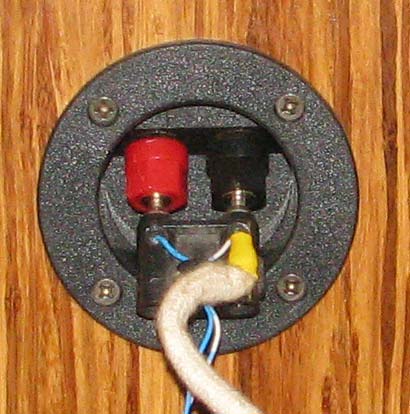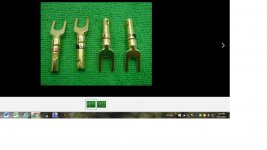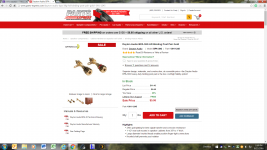Hi all, my guess is that stand-alone posts will make for better cabinet performance. i.e. more rigid rear panel and less chance of leakage, but wanted to make sure. I'm planning to install binding posts directly into the rear panel plywood. Am I on the right track with this? I'm building a batch of Auratone-style cabs, similar to the one in this schematic...
https://imgur.com/HlUBacg
any suggestions greatly appreciated. thanks!
https://imgur.com/HlUBacg
any suggestions greatly appreciated. thanks!
I go not like terminals just mounted on the back. Hard to get at to solder or change wire, and easily knocked off as they are exposed. And often done without ¾” standard spacing.
We ended up searching down a 2” round terminal cup for minimum panel impact, can be prepared for with a 2” holesaw, recess the standard space terminals, can be removed if rewiring required. They come with cheesy looking 5 way posts, but they have low metal content and as such sound better than many much pricier/blingier posts. It is tight to use the terminals with bare wire or spades (but if you are connecting that way, likely only once) and an absolute dream if you are using double bananas.

If you want to soup them up, one can fit more exotic 5-way posts.
We ended up searching down a 2” round terminal cup for minimum panel impact, can be prepared for with a 2” holesaw, recess the standard space terminals, can be removed if rewiring required. They come with cheesy looking 5 way posts, but they have low metal content and as such sound better than many much pricier/blingier posts. It is tight to use the terminals with bare wire or spades (but if you are connecting that way, likely only once) and an absolute dream if you are using double bananas.

If you want to soup them up, one can fit more exotic 5-way posts.
oidua5,
I'm very much a newbie in regards to cabinet construction, but in my limited experience its hard to beat a well designed stand alone posts for ease of assembly. This is the combo that I have landed on (see attached photos). These binding posts are well made and seem like a good price. The Nakamichi spade terminals are also well made and work awesome with these binding posts. Dave and Chris really know their stuff and I'm not trying to discredit their input, just giving another option to consider.
Best Regards,
Rich
I'm very much a newbie in regards to cabinet construction, but in my limited experience its hard to beat a well designed stand alone posts for ease of assembly. This is the combo that I have landed on (see attached photos). These binding posts are well made and seem like a good price. The Nakamichi spade terminals are also well made and work awesome with these binding posts. Dave and Chris really know their stuff and I'm not trying to discredit their input, just giving another option to consider.
Best Regards,
Rich
Attachments
Maybe. What about spade vrs bare wire? That was the comparison i was making.
Possibly the best is to run the internal connection out of the box and use the binding posts to clamp bare wire to bare wire.
Nothing beats the dual bananas for being able to swap a set of speakers in minimum time and effort.
dave
Possibly the best is to run the internal connection out of the box and use the binding posts to clamp bare wire to bare wire.
Nothing beats the dual bananas for being able to swap a set of speakers in minimum time and effort.
dave
The Best is not to have any, solder your speaker cable straight to the crossover & glue it through a hole in the back of the speaker & while in there switch out the stock wire for some better hookup wire plus if there are metal tabs used in your crossover that the various parts are soldered to, disconnect the parts from the metal tabs & solder it all up wire to wire. If there is a crossover move it out of the box also. This will give you a major component upgrade like no other that's so easy to do.
Last edited:
Thanks,
I'll have to give that tip a try. I do have one build with solder tabs used. Not sure how easy it would be to remove components at this point without frying some rather expensive capacitors. Moving forward in future builds, I will solder it all wire to wire.
Best,
Rich
I'll have to give that tip a try. I do have one build with solder tabs used. Not sure how easy it would be to remove components at this point without frying some rather expensive capacitors. Moving forward in future builds, I will solder it all wire to wire.
Best,
Rich
ABTN - it is possible to get too "hair-shirt" about all this. "Back in the day" ( mid 80's), I knew a guy who talked about hard-wiring /soldering a complete system from immediately after the tone-arm litz wire to the speakers to avoid as many mechanical connectors/ contact points subject to corrosion, etc , as possible. And Dave, his initials weren't LR. After that much effort of course you're gonna convince yourself that "curtains were lifted, dude!" - but moving or switching components must have been a bit of a Pythonesque little skit.
"Ponsonby, that's just the right spot for it, but now, old chap, it's out of (absolute) phase, and the channels are reversed"
"No, 'snot, - and you know, of course, Faversham, that one if those is mythical, and if you listened in mono, as Edison had envisioned, the other would be irrelevant"
" I beg to differ, you cheeky bugger"
"Good luck moving anything else now, you old fart- I'll see you and the rest of the boys at the Club on Saturday, next"
harrumph, and chuff-chuff
Cleese/Jones/ Palin/Chapman/Idle - a bloody national treasure, whot?
Ooh, that was fun - back to topic of the day.
This is after all the full-range forum - generally targeted at single driver per channel - or bi-amped FASTs - with no passive speaker level crossover networks, and certainly within the last few years much of any BSC filtering or other EQ as might be deemed appropriate can be achieved by DSP - so the need for all those components, contact points, etc is eliminated.
I'd also be interested in a rigorous double blind test to determine exactly how much all those suspect / redundant contact points diminish the in room audible results.
It'd be fun to be the monkey behind the curtain on that one
"Ponsonby, that's just the right spot for it, but now, old chap, it's out of (absolute) phase, and the channels are reversed"
"No, 'snot, - and you know, of course, Faversham, that one if those is mythical, and if you listened in mono, as Edison had envisioned, the other would be irrelevant"
" I beg to differ, you cheeky bugger"
"Good luck moving anything else now, you old fart- I'll see you and the rest of the boys at the Club on Saturday, next"
harrumph, and chuff-chuff
Cleese/Jones/ Palin/Chapman/Idle - a bloody national treasure, whot?
Ooh, that was fun - back to topic of the day.
This is after all the full-range forum - generally targeted at single driver per channel - or bi-amped FASTs - with no passive speaker level crossover networks, and certainly within the last few years much of any BSC filtering or other EQ as might be deemed appropriate can be achieved by DSP - so the need for all those components, contact points, etc is eliminated.
I'd also be interested in a rigorous double blind test to determine exactly how much all those suspect / redundant contact points diminish the in room audible results.
It'd be fun to be the monkey behind the curtain on that one
Last edited:
If hardwiring you don't need a double blind test unless maybe one is very hard of hearing? It is so obvious the difference that it makes you giggle & laugh out loud at the incredible increase in fidelity, & then you start digging in your collection to rediscover what you thought you knew about your favourites & discover new ones too 
....It is so obvious the difference that it makes you giggle & laugh out loud at the incredible increase in fidelity
Time to call B... S...! Tweaks of this nature can make small differences, the type of thing that might be heard in a proper ABX test. but incredible -- huge -- day and night? No, these are the terms snake oil salesmen pass off on audiofools.
Bob
Last edited:
Some of the advantages of speakons:
1. It is impossible to short out the terminals when hot swapping speakers (but no one would do that, would they?)
2. They are very secure and at least semi-childproof. To remove the plug, you have to push a button and rotate the shell.
3. There is very little metal in the signal path.
4. Quick switch between speakers. I use 4-pole speakons on single-driver speakers and 2-way FAST speakers. The same cables are used for both. Just turn on the proper amps and set the DSP/crossover for the speakers in use.
Bob
1. It is impossible to short out the terminals when hot swapping speakers (but no one would do that, would they?)
2. They are very secure and at least semi-childproof. To remove the plug, you have to push a button and rotate the shell.
3. There is very little metal in the signal path.
4. Quick switch between speakers. I use 4-pole speakons on single-driver speakers and 2-way FAST speakers. The same cables are used for both. Just turn on the proper amps and set the DSP/crossover for the speakers in use.
Bob
And they come with a worthy gasket to seal them.
attached
dave
Can you point us towards were we can get these?
- Status
- This old topic is closed. If you want to reopen this topic, contact a moderator using the "Report Post" button.
- Home
- Loudspeakers
- Full Range
- What's best: stand-alone binding posts or terminal cups?

